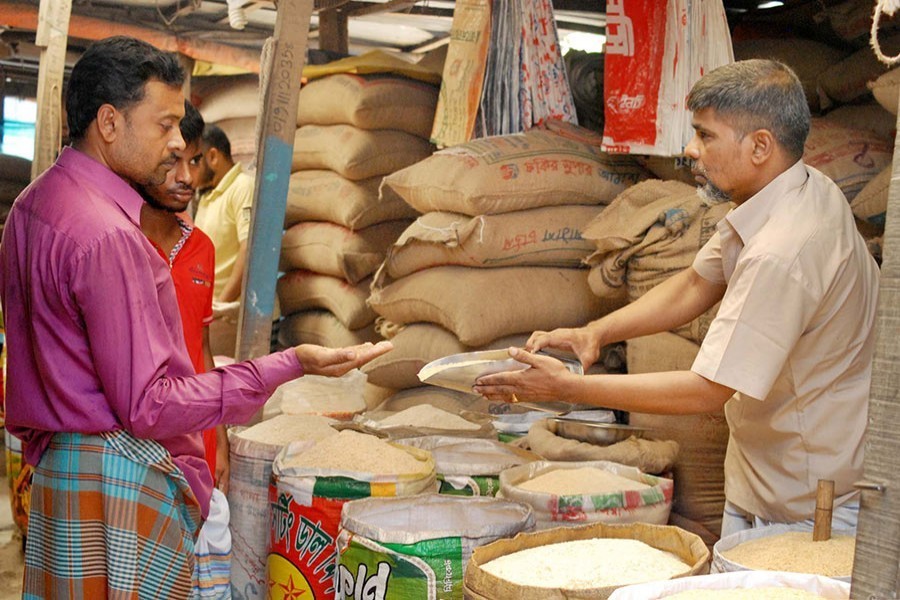
Published :
Updated :

We have been hearing about the introduction of commodity exchange in the country for some time now. The concept though new to many of us, is quite familiar in the neighbouring countries which have set up commodity exchanges of selected items as an effective measure of market stability. India, Pakistan and Nepal are among the neighbours who are ahead of us in setting up commodity exchanges. In Bangladesh, way back in 2007, the government initiated a move to establish a commodity exchange system which did not materialise due to reported complexities relating to some basic infrastructure issues such as warehousing facilities. Besides, a lack of interested traders is also believed to be a reason for the non-starter.
Now the Chittagong Stock Exchange (CSE) is set to go for the country's maiden Commodity Exchange within a year, according to reports. The decision of CSE came following the nod of the Bangladesh Securities and Exchange Commission (BSEC) last year. The BSEC expects to preliminarily include gold, industrial raw materials such as iron ore, and tea in the exchange.
According to the CSE chairman, research has shown that the size of the commodity market in Bangladesh is more than $144 billion. Only for the country's garment sector, a huge amount of cotton has to be imported from abroad. The garment industry will benefit if the companies that buy cotton in the country and the companies that sell cotton internationally can be brought to the commodity exchange market.
A commodity exchange is a system of legal framework where various commodities are traded, with rules and procedures for trading standardised commodity contracts and related investment products. The transactions take place either on paper or electronically. The product remains in a shop, warehouse or field. From there, it is finally disposed of or handed over after a certain time.
According to the Securities and Exchange Ordinance 1969, any product such as agricultural items, livestock, fish, forest resources, minerals and energy products can be traded under the commodity exchange. The exchange or organisation that is formed to trade these products will be known as a commodity exchange.
Through the futures market, a farmer or entrepreneur will go into production after being sure of the price of his products before the start of the season. In this way, the commodity exchange will work to build a secure marketing system. Through this, farmers and farmers' cooperatives will be sure to get a fair price. At the same time, there is little risk due to crop failure, so buyers are likely to get the product at a fair price. The exchange facilitates the participation of farmers alongside financing for them while the producers will have to avail of insurance.
The purposes served by a commodities exchange depend in part on the nature of the specific contracts that are traded. By simply centralising trade on a certain commodity, an exchange can facilitate title transfer, market transparency, and price discovery. Transaction costs are reduced because coordination through a centralised exchange can reduce costs associated with identifying market outlets, physically inspecting product quality, and finding buyers or sellers. By reducing transactions costs and enhancing the flow of information, an exchange can improve returns to market agents while reducing short-term price variability and spatial price dispersion.
While future contracts effectively remove price level risk, they do not eliminate risk altogether. Rather, they replace price risk with basis risk, where the basis is the difference between the spot market and futures market prices. Unanticipated shifts in the basis can result in gains or losses, and the degree of basis risk can strongly influence the effectiveness of the exchange in risk management.
The important aspect of Commodity Exchange is that it helps increase the liquidity for farmers since it assists them to access funds without any interest. According to experts, a commodity exchange allows farmers to lock in prices using forward contracting. This also reduces the risk of a drastic price drop. As a result, they don't need to borrow at higher interest rates from sources such as banks or usurers.
There are indeed many pros and cons, not as simplistic as stated above, which need to be familiarised with before embarking on the new mode of exchange marketing in the country. Keeping this in view, the CSC has signed a memorandum of understanding (MoU) with the Multi Commodity Exchange of India (MCX) to appoint it as a consultant. In 2003, MCX became one of the first exchanges to open in India. It provides a platform for price discovery and risk management across varied segments, including industrial metals, energy and agricultural commodities. MCX will recommend bylaws and regulations based on generic regulatory compliance and international best practices, products, clearing and settlement methods, trading and surveillance systems, warehousing, delivery infrastructure and partnership models.
As of now, most people associated with stocks have welcomed the move, including economists. Many hold the view that including horticulture products like potato, onion, spices, tomato among others would be a huge turning point, if fair price could be ensured through the exchange to the benefit of both the growers and consumers. It is expected that in order to make the relevant quarters, including farmers and business community, well-familiar with the functioning and technicalities involved in the exchange, the authorities concerned would launch country-wide campaigns as well as dissemination workshops. The media can also be taken on board to raise literacy on Commodity Exchange.


 For all latest news, follow The Financial Express Google News channel.
For all latest news, follow The Financial Express Google News channel.